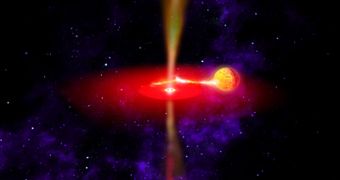A recently developed method has successfully been applied for weighing a black hole named Cygnus X-1, located in the constellation Cygnus (the Swan) approximately 10 000 light years away in our Galaxy, the Milky Way.
A black hole is an object with a gravitational field so powerful that a region of space becomes cut off from the rest of the universe - no matter or radiation (including light) that has entered the region can ever escape.
Nikolai Shaposhnikov and Lev Titarchuk, at NASA's Goddard Space Flight Center (GSFC) have pioneered the measuring technique and applied it to the singularity. They concluded that Cygnus X-1, part of a binary system, contains 8.7 solar masses, with a margin of error of only 0.8 solar masses.
"This agreement gives us a lot of confidence that our method works," says Shaposhnikov. It can help determine a black hole's mass when alternative techniques fail," adds Titarchuk.
The method uses the relationship between the black hole and its surrounding accretion disk - the gas nearest the event horizon compressed to a relatively high density. This gas eventually spirals into the black hole and if the accretion rate increases to a high level, material piles up near the black hole in a hot region that Titarchuk likens to a traffic jam.
He found that the distance from the black hole where this "traffic jam" appears and the mass of the black hole itself are closely related and that can be used to measure its mass. He explained that the hot gas gathering in the accretion disk is related to the intensity variations of the X-rays emitted by the black hole, which follow an almost periodic pattern, called Quasi-Periodic Oscillations (QPOs).
The two researchers applied the method to three black holes in our galaxy and proved that the derived masses from the QPOs concur with mass measurements from other techniques, thus demonstrating the effectiveness of their work.

 14 DAY TRIAL //
14 DAY TRIAL //